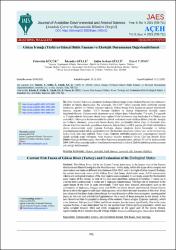Göksu Irmağı (Türkiye) güncel balık faunası ve ekolojik durumunun değerlendirilmesi
Künye
Küçük, F., Gülle, İ., Güçlü, S.S. & Turan, D. (2021). Göksu Irmağı (Türkiye) Güncel Balık Faunası ve Ekolojik Durumunun Değerlendirilmesi. Journal of Anatolian Environmental and Animal Sciences, 6(4), 705-711. https://doi.org/10.35229/jaes.1002412Özet
Orta Toroslar’daki karst alanlardan beslenen Göksu Irmağı, Doğu Akdeniz Havzası’nın Akdeniz’e
dökülen en büyük akarsuyudur. Bu çalışmada, 2014-2017 yılları arasında farklı tarihlerde yapılan
örnekleme, gözlem ve literatür taraması ışığında; Göksu Irmağı balık faunasının güncel taksonomik
durumu, dağılım alanları, IUCN koruma ölçütleri ve akarsu bölgelerinin ekolojik yapısı
değerlendirilmiştir. Çalışmamızda akarsuyun acısu bölgesi hariç 8 familyadan; 7’si yerli, 2’si egzotik
ve 2’si göç eden tür (diadrom) olmak üzere toplam 11 tür belirlenmiş olup, bunlardan 6’sı Türkiye için
endemiktir. Akarsuyun üst havzasındaki bu yüksek endemizm oranı oldukça dikkat çekicidir. Irmağın
ana kollarını oluşturan, yukarı-orta havza drenaj alanı içerisindeki Göksu Çayı ve Ermenek Çayı
(Gevne Çayı)’nın üzerinde gerçekleşen karayolu, köprü, baraj ve HES yapımı gibi fiziki tahribatların
akarsu ekosisteminin doğal yapısını bozduğu, akarsu yatağında kısmi kurumalar ve habitat
parçalanmasına neden olduğu gözlemlenmiştir. Bu baskılar sonucunda, Göksu Çayı ve Gevne Çayı’nın
baskın balık türü olan endemik Toros sirazı (Capoeta caelestis) popülasyon yoğunluğunun önemli
ölçüde azaldığı tespit edilmiştir. Aynı olumsuz etkenler nedeniyle Gevne Çayı’nın Beyreli Köyü
(Hadim-Konya) ile Dumlugöze (Sarıveliler-Karaman) arasında kalan yaklaşık 45 km’lik üst kesiminde
2004-2009 yılları arasında nadiren örneklenen kırmızıbenekli alabalık (Salmo opimus) popülasyonunun
yok olduğu belirlenmiştir. The Göksu River, fed by the Central Taurus karst areas, is the largest river of the Eastern
Mediterranean Basin flowing into the Mediterranean. In this study, within the scope of the samples and
observations we made on different dates between 2014-2017, and in the light of other research findings;
the current taxonomic status of the Göksu River fish fauna, distribution areas, IUCN conservation
criteria and ecological structure of the river regions were evaluated. In our study, except for the brackish
water region of the stream; A total of 11 taxa were identified, belong to 8 families; 7 native (as 6
endemic and 1 widespread), 2 exotic and 2 migratory (diadromous). The high rate of endemism in the
upper basins of the river is quite remarkable. There have been physical destructions such as the
construction of highways, bridges, dams and HEPPs on Göksu Stream and Ermenek Stream (Gevne
Stream) within the upper-middle basin drainage area, which form the main branches of this river. It has
been observed that these destructions disrupt the natural structure of the river ecosystem, causing partial
drying in the river bed and habitat fragmentation. As a result of these pressures on the stream, it has
been determined that the population density of the endemic Taurus scraper (Capoeta caelestis), which
is the dominant fish species of Göksu and Gevne streams, has decreased significantly. Due to the same
negative factors, it was determined that the red spotted trout (Salmo opimus) population, which was
rarely sampled between 2004 and 2009, disappeared in the upper part of the Gevne Stream,
approximately 45 km between Beyreli Village (Hadim-Konya) and Dumlugöze (Sarıveliler-Karaman).


















